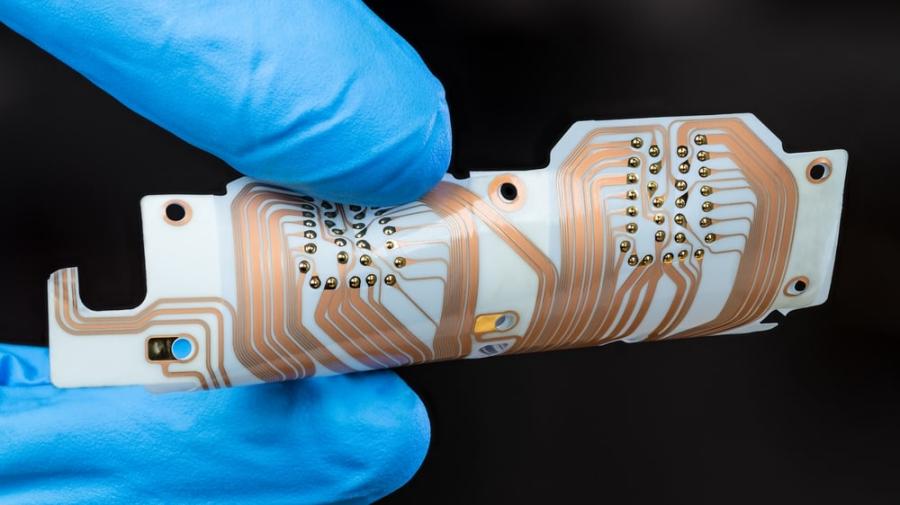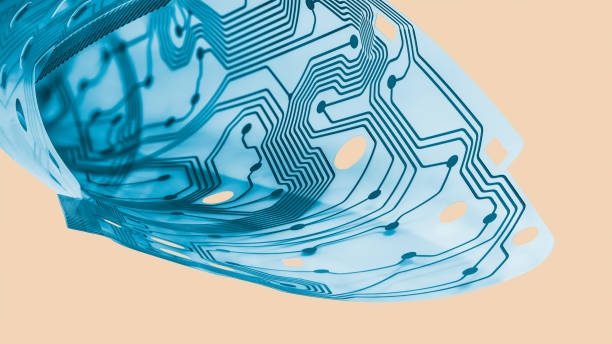Traditional rigid circuit boards have been foundational in electronic devices due to their sturdy and fixed designs. However, advancing technology has spurred the need for more adaptable and space-efficient solutions, leading to the creation of bendable circuit boards, or flexible PCBs. These cutting-edge components offer exceptional flexibility, enabling them to conform to diverse shapes and fit into compact spaces crucial for modern electronics such as wearables and medical devices. BEST FPC aims to distinguish itself as China's premier provider of fast circuit board and metal dome solutions by 2025, advancing innovation in flexible technology.

Understanding Bendable Circuit Boards
Definition and Structure of Flexible PCBs
Flexible printed circuit boards (flexible PCBs) are designed to flex and conform to various shapes, unlike rigid PCBs which are inflexible. These boards employ a flexible substrate material, typically polyimide or polyester, allowing them to bend or fold without compromising their electrical connectivity. This flexibility is essential in applications where space constraints or unconventional shapes require adaptable electronics solutions.
Materials Utilized in Manufacturing
Flexible circuits and flex printed circuits (FPC) are manufactured using a diverse range of materials, selected for their specific properties that enhance circuit performance. The most common material is Polyimide (PI), commercially known as "Kapton" by Dupont. Polyimide offers exceptional thermal stability, capable of withstanding temperatures exceeding 500°C, alongside mechanical robustness and resistance to chemicals. Its superior dielectric properties and low coefficient of thermal expansion make it ideal for demanding applications where reliability is paramount.
Advantages Compared to Rigid PCBs
Flexible PCBs offer several advantages over traditional rigid PCBs, including flexibility, durability, and lightweight construction. Their ability to bend and conform allows for intricate and space-efficient designs, crucial in compact electronic devices. This flexibility also enhances durability by reducing mechanical stress and potential damage from impacts. Moreover, their lightweight nature contributes to overall weight savings, benefiting portable electronics where weight reduction is critical.
Applications of Bendable Circuit Boards
Consumer Electronics
Flexible PCBs play a pivotal role in consumer electronics, enabling the development of sleek and compact designs. They are extensively used in smartphones for connecting components in tight spaces and in wearable technology, where their flexibility supports ergonomic designs that enhance user comfort and device functionality.
Medical Devices
In the medical field, flexible PCBs are indispensable, especially in implantable devices and wearable health monitors. These applications demand reliable, compact electronics that can conform to the body’s contours while meeting stringent medical standards for performance and safety.
Automotive Industry
The automotive sector utilizes flexible PCBs for in-vehicle electronic systems, particularly in flexible displays that seamlessly integrate into curved interiors and in lighting applications where traditional rigid boards are impractical. This adaptability enhances design flexibility and durability in demanding automotive environments.
Aerospace
Flexible PCBs are critical in aerospace applications where reliability and space efficiency are paramount. They are employed in satellites for their lightweight construction and ability to fit into confined spaces. In aircraft instrumentation, their resilience to harsh conditions and ability to conform to complex shapes ensure consistent performance in challenging aerospace environments.
Best FPC's Manufacturing Expertise
Tailored Thickness for Diverse Applications
Best FPC specializes in crafting flexible circuits with tailored thicknesses to suit specific application requirements. Thinner circuits are preferred in medical devices for their flexibility and space efficiency, whereas thicker circuits excel in industrial and automotive settings, offering superior tensile strength and resilience against high temperatures and mechanical stress. This variability ensures optimal performance and durability tailored to each application's demands.

Enhancing Structure with Stiffeners
Stiffeners are integral to the structure of flexible printed circuits (FPCs), providing necessary rigidity to designated areas. They facilitate the soldering of connectors and surface-mounted devices, enhancing overall robustness and simplifying assembly processes. Best FPC offers a range of stiffener materials such as polyimide and FR4, customizable to meet specific project needs. Selecting the right stiffener material is crucial as it directly impacts assembly efficiency and the final functionality of the flexible circuit.
Comprehensive Fabrication Capabilities
Best FPC boasts extensive fabrication capabilities tailored to diverse design requirements. The company excels in producing multilayer circuitry spanning from 3 to 14+ layers, utilizing advanced techniques including adhesive-based and adhesiveless constructions. Surface finish options such as ENIG, immersion silver, and electroplated nickel/gold cater to varied application needs. Additionally, Best FPC integrates EMI shielding and precise impedance control (with values like 50 ohm and 100 ohm) into its manufacturing processes, ensuring high-performance standards. Their expertise extends to producing ultra-thin circuits, with the thinnest single-layer flex circuit measuring only 0.06mm, underscoring their leadership in cutting-edge flexible PCB technology.
Benefits and Advantages
Flexibility and Durability
Flexible PCBs are celebrated for their ability to bend and twist without sacrificing functionality, making them ideal for dynamic applications where traditional rigid boards may not suffice. This inherent flexibility also enhances their durability, as they can withstand physical stresses better than rigid counterparts, thereby reducing the risk of damage during use and handling.
Reduced Space and Weight
Among the most significant advantages of flexible PCBs is their role in minimizing space and weight in electronic devices. These boards are exceptionally thin and lightweight, enabling designers to incorporate more technology into smaller spaces without adding unnecessary bulk. This feature is particularly advantageous in industries such as aerospace and consumer electronics, where weight reduction is critical for performance and efficiency.
Enhanced Design Possibilities
The flexibility of flexible circuit boards opens up a wealth of design possibilities that are impractical with rigid PCBs. They can be folded, curved, or shaped to fit unconventional layouts, facilitating innovative product designs that optimize space and functionality. This adaptability is crucial for creating modern, compact electronic devices that not only perform well but also offer aesthetic appeal and ergonomic benefits.
Cost-effectiveness in Certain Applications
Flexible PCBs offer a cost-effective solution in applications where reducing space and weight can lead to overall savings. While initial costs may be higher than rigid PCBs, the long-term benefits include enhanced device reliability, reduced material requirements, and simplified assembly processes. This makes them a viable choice, especially in high-volume production scenarios where efficiency and performance are paramount.
Examples
Example 1: Application in Wearable Technology (Smartwatches)
Flexible PCBs have revolutionized wearable technology, particularly in smartwatches. They enable seamless integration of sensors and displays, conforming to ergonomic designs that enhance comfort and usability. By allowing components to wrap around the wrist, these circuits improve both the functionality and user experience of wearable devices.
Example 2: Medical Applications (Flexible Sensors)
In the medical field, flexible PCBs play a crucial role in the development of sensors that can be used on or inside the body. These sensors offer continuous health monitoring with minimal intrusion, facilitating precise and comfortable patient care. For instance, flexible PCBs are integral to advanced prosthetics, enabling natural movement and precise control by conforming to the body's contours.
Example 3: Automotive Industry (Flexible Displays)
The automotive sector benefits from flexible PCBs in creating interactive and visually appealing user interfaces. Flexible displays integrated into curved surfaces of vehicle dashboards enhance visibility and provide a futuristic aesthetic. This application not only improves functionality by optimizing space but also enhances the overall design appeal of automotive interiors.
Future Trends and Innovations
Emerging Technologies (Stretchable Circuits, Foldable Displays)
Future developments in PCB technology are focusing on stretchable circuits and foldable displays, which promise greater flexibility and expandability. These innovations could revolutionize electronics by enabling dynamic applications such as expandable screens and devices that seamlessly adapt to various environments, paving the way for more versatile and adaptive technologies.
Potential Advancements in Materials and Manufacturing Techniques
Ongoing research is exploring new materials and manufacturing techniques for flexible PCBs to enhance performance and durability. Advances in substrates and conductive materials are expected to offer higher reliability and environmental resistance, while improvements in manufacturing processes aim to reduce costs and increase accessibility. These advancements will likely accelerate the adoption of flexible PCBs across diverse industries.
Predictions for Future Market Growth and Adoption
The market for flexible PCBs is poised for substantial growth as industries recognize the advantages of these versatile circuits. Increasing demand for compact and sophisticated electronics in sectors such as consumer electronics, healthcare, and automotive is driving this growth. As technology evolves, flexible PCBs are expected to play a pivotal role in fostering new innovations and applications, expanding their presence in the global electronics market.
Closing Words
In summary, flexible PCBs are transforming the electronics industry with their exceptional flexibility and adaptability. These components enable the creation of compact, ergonomic device designs that seamlessly integrate into diverse applications, from wearable technology to automotive displays. Their capability to endure physical stresses while minimizing space and weight is crucial in modern electronics manufacturing. As technology progresses, flexible PCBs are expected to lead further innovations, including stretchable circuits and foldable displays. Embracing these advancements positions the electronics sector for significant growth, solidifying flexible PCBs as pivotal in advancing technological frontiers.










 2024-06-21
2024-06-21
 BEST
BEST

.png)
.png)
.png)
.png)

.png)

